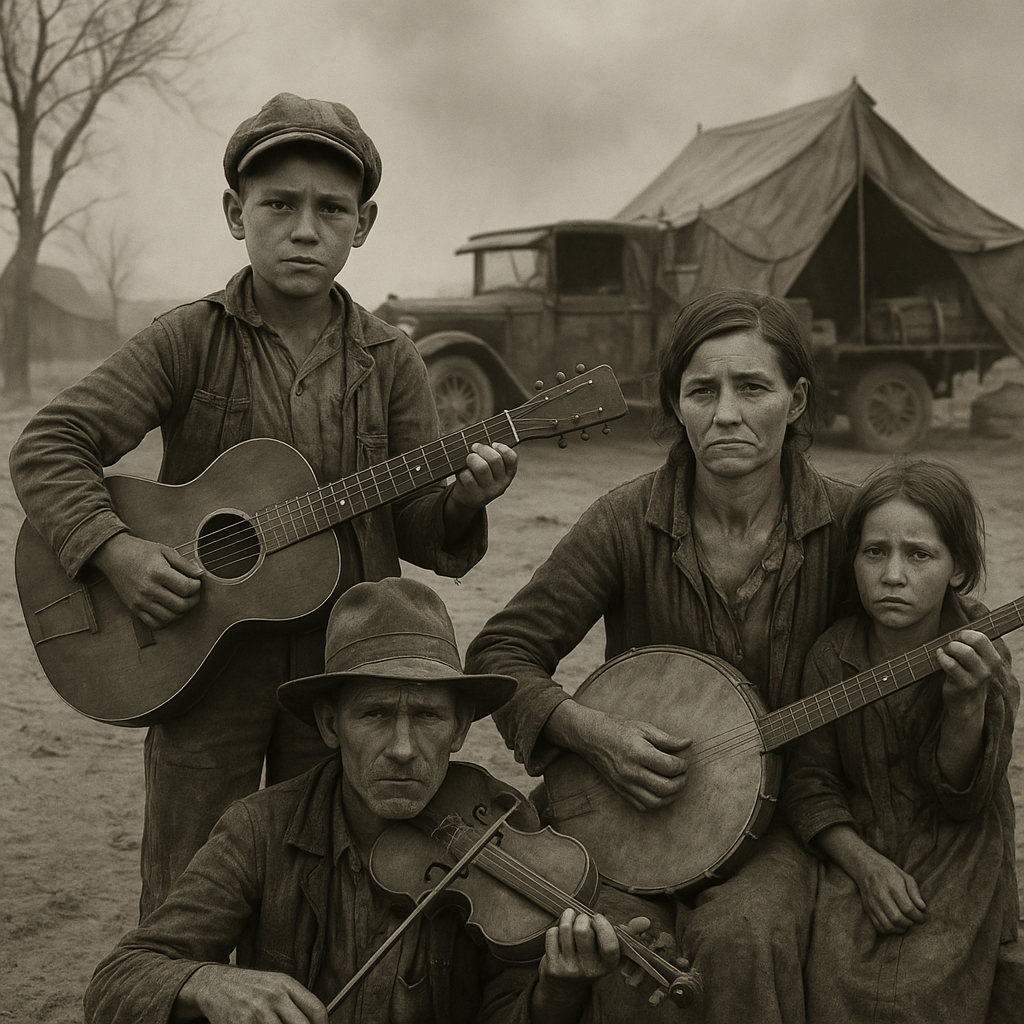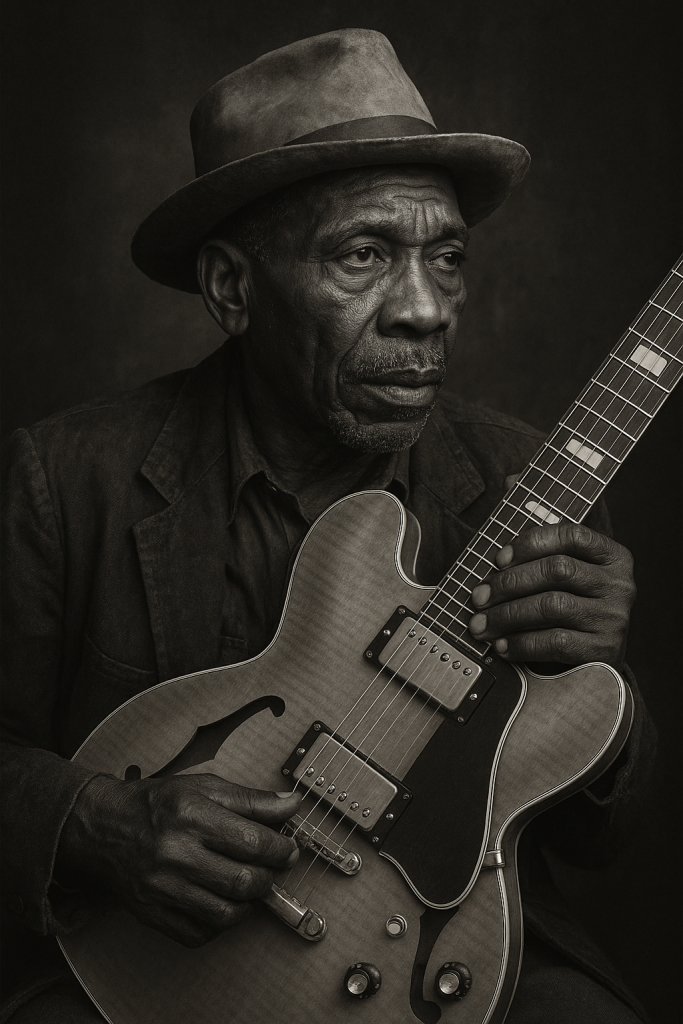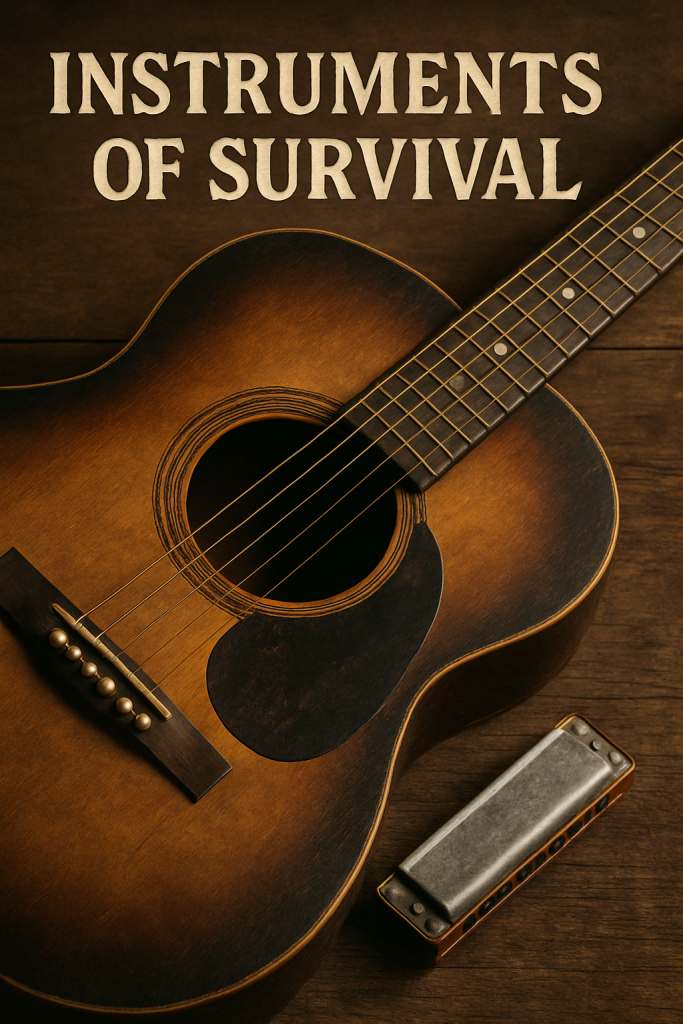Introduction-Music in Hard Times
.Dust choked the air. Streets and fields shimmered in hazy heat. Inside Texas juke joints, electric guitars screamed defiance against the gloom. Meanwhile, beyond the walls, the land and its people endured relentless hardship. Crowds packed the rooms, desperate for escape from hunger, fear, and relentless dust storms.
The Great Depression ground down lives across America. Banks failed, farms withered, and millions lost their jobs. Families clung to melody, radio, and each other, drawing strength and comfort in troubled times.
In Texas, this nationwide collapse took a unique shape. Farmers battled drought, while cities swelled with displaced workers searching for opportunity.
Out of pain and loss, sound became both escape and protest. Depression-era Texas blues filled dance halls, street corners, and cotton fields. Musicians held guitars like lifelines, singing of empty tables, broken dreams, and vanished work. Their verses were intimate, yet universally understood.
Yet Texas blues was not all sorrow and grief. Driving rhythms and relentless guitar lines spoke of endurance. For a time, audiences could laugh, dance, and briefly forget their misery. This blend of grief and grit shaped the beating heart of Texas blues tradition.
As trials deepened, identity was forged. Texas blues became the voice of laborers, migrants, and struggling families. It was fortitude set to rhythm, persistence strummed through strings, and community built from sound.
In the end, Great Depression Texas blues proved adversity could not silence creativity. Instead, it transformed it into music of endurance, heritage, and spirit.
To truly grasp this transformation, we must look closely at Texas adversity, determination, and the melodies born from crisis.

The Great Depression Hits Texas
Texas bore the full weight of the nation’s downfall in the 1930s. Banks shut down, jobs disappeared, and families scraped by day to day.
Cities were plagued by unemployment and breadlines. Desperation grew as once-thriving businesses closed, leaving workers with no income during the Texas Great Depression.
In contrast, rural Texas was devastated by the Dust Bowl. Crops failed, and families abandoned land that no longer produced food.
As conditions worsened, dust storms swallowed fields and homes, destroying livelihoods. Livestock perished, and communities scattered, seeking life and optimism elsewhere amid severe Depression ordeals.
Even in suffering, the crisis left lasting scars on Texas communities. Neighbors shared food, stories, and dignity, relying on one another to endure.
Yet from devastation, music was born. The sound of Texas blues carried people through the darkest days, offering grit, character, and strength
Why Texas Blues Was Different
The Texas blues style was distinct compared to other regional traditions. It stood apart from Delta blues with its emphasis on melody over raw emotion. Chicago blues, with its electrified sound and gritty city themes, also contrasted with the more diverse Texas approach.
The contrast between Texas blues and Delta blues is clear in the music itself. While Delta blues emphasized difficulty and storytelling, Texas songs allowed room for humor and exploration. Guitar work in Texas often featured fluid lines, drawing from a broader range of influences.
Swing, country, and Mexican folk traditions significantly shaped the Texas sound. Swing rhythms, country storytelling, and Mexican folk melodies blended into Texas blues, creating a rich, varied style.
Migration and cultural exchange became hallmarks of Texas blues. Workers, migrants, and musicians brought their traditions to juke joints, dance halls, and urban areas. These interactions sparked new sounds and made Texas blues more versatile.
The regional identity of Texas blues reflected toughness and ingenuity. It was music rooted in both heritage and experimentation.
The distinctive sound of Texas blues grew more pronounced as life became harsher, setting the stage for its next chapter.
Life Struggles in the Lyrics
Blues verses often described hunger, poverty, and homelessness. Every line felt like a fight to endure. These weren’t just words—they reflected people’s real lives.
During the Depression, songs blended truth, humor, and irony with powerful storytelling. Have you ever laughed at a joke, even when life felt unbearably heavy? That’s what these ballads did. People chuckled, but the pain remained.
Texas blues lyrics functioned like a local newspaper. How else could poor families share their experiences when they had no press? Music spread tales of loss, effort, and persistence. Verses captured the burdens of everyday living and preserved memories.
Blues also connected generations. Can you imagine a song carrying your family’s story for decades? That’s what these lines accomplished. They spoke of hunger, travel, and perseverance while showing pride and strength.
Behind the words stood musicians carrying their community’s weight. In the end, their melodies turned private struggles into lasting Texas blues history.

Texas Blues Pioneers in Hard Times
.Lightnin’ Hopkins embodied the grinding, haunting sound of poverty. His music was gritty, personal, and deeply familiar. His songs turned pain into power and endurance into strength. That’s why Hopkins was celebrated as a hero for ordinary people.
But earlier still, Blind Lemon Jefferson shaped Texas blues. His high-pitched voice and unusual guitar style inspired a generation of Depression-era players. Though Jefferson died in 1929, his impact peaked during the hungry thirties. The raw honesty in his lines revealed weakness but also uncovered hidden grit. Isn’t that what blues is about—finding strength in crisis? His music became a guide for younger Texas musicians.
Then came T-Bone Walker, whose electrifying guitar revolutionized Texas blues. His sound was polished, glamorous, and worlds apart from Hopkins’ rustic style. Walker blended swing, jazz, and electric guitar into a bold, modern form. His dazzling performances showed the music could evolve and adapt. Who could ignore the spark of electricity in his playing? He lifted Texas blues to dazzling new heights.
Each of these pioneers represented a unique part of Texas blues. Hopkins brought raw endurance, Jefferson gave lasting influence, and Walker added electrifying change. Their music spoke of hunger, survival, and the promise of brighter days. Don’t you think people needed that promise most during the Depression? Through their sound, Texans found a way to keep moving forward.
Finally, these musicians traveled far and wide, carrying their music to new listeners and spreading its legacy.
Migration and the Spread of Texas Blues
Dust Bowl migrants’ songs carried the voices of people displaced by environmental and economic disaster. Their music told stories of hunger, loss, and perseverance.
As they traveled west, migrants brought these ballads with them, shaping the cultural landscape of their new communities. Could music really carry so much history? Absolutely.
Migrant performers also passed along family traditions and migration stories, weaving them into the evolving Texas sound. This helped the style remain deeply personal.
In search of work, many musicians headed to California and other growing cities. There, Texas blues quickly found eager audiences already familiar with its rhythms.
In these new places, sound provided income for performers and comfort for struggling communities. Isn’t it amazing how music heals both body and spirit?
At the same time, the new environments influenced the style itself. Texas blues merged with jazz, swing, and urban blues. These fusions created fresh subgenres filled with unique rhythmic blends.
Guitar riffs soared, while horns and vocals added both sorrow and joy. The cross-pollination of traditions kept Texas blues alive, relevant, and constantly evolving.
As instruments improved, the sound shifted further. Electric guitars and amplified bands gave Texas blues a new intensity. Can you imagine hearing that electrifying change for the first time?

The Guitar and Harmonica: Instruments of Escape
During the Depression, endurance meant making do with little. Instruments had to be cheap, portable, and useful. The guitar and harmonica fit perfectly.
Easy to carry and simple to learn, these tools gave people a way to express themselves when hope and funds ran low.
But why did the guitar resonate so strongly with struggling communities? Texas blues guitar delivered rhythm and melody that spoke directly to the poor. Acoustic instruments were affordable when pianos and horns were out of reach.
Street musicians, sharecroppers, and traveling singers used their guitars to share stories of hardship and determination. From dusty porches to noisy juke joints, the guitar became a defiant voice of survival.
Then came a revolution. T-Bone Walker’s electric guitar transformed Texas blues. Amplification gave the sound presence that acoustic instruments could never achieve.
Now the guitar was bold, brash, and unmistakably modern. Amplified tones cut through crowded bars and busy streets, paving the way for rock and roll.
The harmonica was no less vital. Small enough to slip into a pocket, it became the voice of poverty. Its piercing tones conveyed hunger, sorrow, and determination in ways words could not.
Though small, the harmonica spoke volumes. It stirred emotion and echoed the weight of endurance with every note.
So what made these instruments truly powerful? Texas blues didn’t just endure—it shaped the future of American music.
Guitar and harmonica became lasting instruments of hope, proving that even in adversity, melody helps people persevere.
Texas Blues Legacy from Depression to Today
The Texas blues legacy began in the 1930s. Musicians turned to music as a way to cope with life during the Great Depression and Dust Bowl years. Their ballads were deeply personal, yet they also spoke to collective struggle. How could such raw emotion not strike a chord?
By the 1950s, the sound grew even stronger. Electric instruments brought energy that elevated Texas blues. T-Bone Walker played a pivotal role, shaping the history of Texas blues with his groundbreaking guitar style. His polished yet powerful sound refined the tradition while amplifying its reach. Because of him, countless artists discovered new pathways forward.
The Texas influence also stretched far beyond state lines. Rock ’n’ roll borrowed its driving boogie-woogie rhythm. Folk musicians embraced the storytelling traditions at its heart. Later, blues-rock bands built entire careers on the Texas heritage. Isn’t it remarkable that one regional style inspired so many genres?
Through every era, determination remained central. Songs of struggle, migration, and endurance carried meaning far beyond Texas. This made the music a symbol of tenacity and authenticity.
Today, the Texas blues tradition lives on through modern bands and solo performers. Listeners still crave its gritty sound and raw passion. With roots planted firmly in hardship, the story of Texas blues continues to resonate across generations.
Conclusion: Keeping the Texas Blues Alive
The Texas blues is the true sound of the Great Depression. The era shaped the soul of this music, giving it strength, character, and timeless staying power. Trials. Migration. Cheap guitars and harmonicas. Fearless pioneers. Preserve their story.
Yet, despite change, the Texas blues never lost its connection to its roots. The guitar’s cry and the harmonica’s wail still carry echoes of those who came before. Doesn’t that enduring connection make the music feel alive even today?
To explore the history of Texas blues is to step into a story of perseverance told through sound. This story deserves to be honored, and more importantly, it deserves to continue. After all, isn’t history meant to inspire us forward as much as it reflects the past?
One powerful way to keep it alive is by supporting today’s and tomorrow’s blues artists. Go to their shows. Buy their albums. Share their music with friends. Every small action helps preserve this legacy. Isn’t it worth giving back to the music that gave so much?
Another way is to pass the tradition on to others. Teach the young about this rich American heritage.
